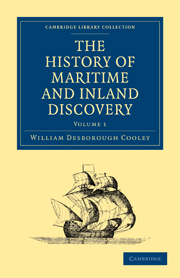Book contents
- Frontmatter
- Contents
- BOOK I GEOGRAPHY OF THE ANCIENTS
- CHAP. I
- CHAP. II THE GREEKS. — HOMERIC AGE
- CHAP. III GREEKS CONTINUED.—HISTORIC AGE
- CHAP. IV THE GREEKS CONTINUED
- CHAP. V GREEKS CONTINUED
- CHAP. VI THE GREEKS CONTINUED
- CHAP. VII DISCOVERY OF THE MONSOONS
- CHAP. VIII PTOLEMY
- CHAP. IX ON THE COMMERCE OP THE ANCIENTS
- CHAP. X MYTHIC GEOGRAPHY OP THE HINDOOS, AND ITS CONNECTION WITH GRECIAN MYTHS
- BOOK II GEOGRAPHY OF THE MIDDLE AGES
- BOOK III PROGRESS OF GEOGRAPHY IN THE MIDDLE AGES
CHAP. X - MYTHIC GEOGRAPHY OP THE HINDOOS, AND ITS CONNECTION WITH GRECIAN MYTHS
Published online by Cambridge University Press: 05 July 2011
- Frontmatter
- Contents
- BOOK I GEOGRAPHY OF THE ANCIENTS
- CHAP. I
- CHAP. II THE GREEKS. — HOMERIC AGE
- CHAP. III GREEKS CONTINUED.—HISTORIC AGE
- CHAP. IV THE GREEKS CONTINUED
- CHAP. V GREEKS CONTINUED
- CHAP. VI THE GREEKS CONTINUED
- CHAP. VII DISCOVERY OF THE MONSOONS
- CHAP. VIII PTOLEMY
- CHAP. IX ON THE COMMERCE OP THE ANCIENTS
- CHAP. X MYTHIC GEOGRAPHY OP THE HINDOOS, AND ITS CONNECTION WITH GRECIAN MYTHS
- BOOK II GEOGRAPHY OF THE MIDDLE AGES
- BOOK III PROGRESS OF GEOGRAPHY IN THE MIDDLE AGES
Summary
Though the Hindoos possess some treatises on geography, yet their language, it is said, does not possess a term to express that useful branch of knowledge. The temper of the Brahminical religion is opposed to every kind of mental acquirement of too practical a characteir to be wholly appropriated by the religious caste. In the Puránáas, or Hindoo sacred poems, there occur many wild systems of cosmology mingled with partial notices of neighbouring nations, alike intrinsically worthless: for what instruction can be derived, in the history of geography, from systems which represent the earth as a lotus flower floating on the surface of the ocean, with Mount Meru rising from the centre as an umbel; or from those which describe it as composed of seven, eight, or nine concentric circles (for these differ in number in the doctrines of different sects) placed round that holy mountain, while the sea between them, mysteriously connected, flows in a spiral line, like the Styx of Grecian mythology?
But among those extravagancies of superstitious fancy, some occasional gleams of an acquaintance with Europe, and still further, numerous allusions to an abode of bliss or imaginary land of peace and happiness, deserve a moment's attention. That myths of this kind should be common to India with Greece and other western nations will not surprise those who reflect on the affinity existing between the languages of India and those of Europe.
- Type
- Chapter
- Information
- The History of Maritime and Inland Discovery , pp. 138 - 153Publisher: Cambridge University PressPrint publication year: 2010First published in: 1830



